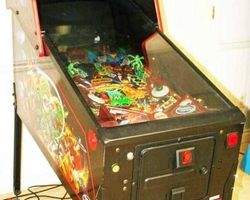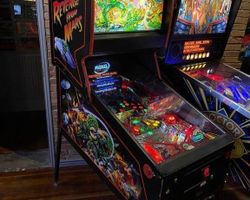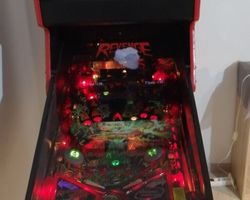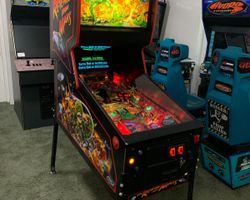Revenge From Mars
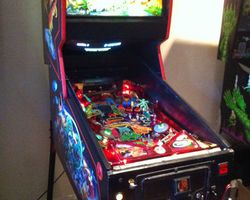
Average Prices: USD $1,300 to $3,200
Produced: January, 1999
Production Run: 6,878 units
Machine Type: Solid State Electronic
MPU: Williams Pinball 2000
Players: 4
Design by: George Gomez
Art by: John Youssi, Greg Freres
Dots/Animation by: Scott Slomiany, Jack Liddon, Adam Rhine, Scott Sanders, Dave Mueller
Mechanics by: Chris Shipman
Music by: Dan Forden
Sound by: Dan Forden
Software by: Dwight Sullivan, Lyman F. Sheats Jr., Graham West, Keith P. Johnson
Released in January 1999, Revenge From Mars emerged from Bally Manufacturing Co. as a bold step in pinball innovation. This machine was conceived as the spiritual successor to Midway's popular Attack From Mars from 1995, continuing the comedic sci-fi theme of Martian invasion. However, Revenge From Mars was more than just a thematic sequel; it represented a technological leap forward as the inaugural title in the Pinball 2000 (PB2K) platform.
The creative force behind Revenge From Mars was a team of notable figures in pinball design. George Gomez spearheaded the design, crafting the gameplay and layout. The distinctive visual style was brought to life by artists Greg Freres and John Youssi, who developed the artwork that blended humor with science fiction. Dan Forden composed the music and sound effects, contributing to the game's immersive audio landscape. Tim Kitzrow, known for his voice work, provided a range of humorous callouts that became integral to the game's personality. On the software side, Dwight Sullivan, Graham West, Keith P. Johnson, and Lyman F. Sheats Jr. programmed the complex rules and interactions that defined the Pinball 2000 experience. Chris Shipman handled the mechanical engineering, ensuring the physical components worked in harmony with the game's technological innovations. The animations that played a crucial role in the Pinball 2000 system were created by Adam Rhine, Dave Mueller, Jack Liddon, Scott Sanders, and Scott Slomiany.
This machine holds the distinction of being the first and, for a time, only Pinball 2000 game in production, preceding Star Wars Episode I. It was also the final pinball machine released under the Bally label, marking a significant point in pinball history as the company transitioned shortly after. An interesting aspect of the Pinball 2000 platform was its modular design, intended to allow operators to easily convert machines between different PB2K titles. This forward-thinking approach was unfortunately cut short due to the closure of Williams, Bally's parent company, soon after the release of Star Wars Episode I, leaving the full potential of the Pinball 2000 system unrealized.
Signature Features and Design
Revenge From Mars is immediately recognizable due to its integration of a video monitor into the pinball playfield, a defining characteristic of the Pinball 2000 platform. This feature was not merely a screen displaying static images; it was a fully interactive display that projected animations directly onto the playfield, blending virtual elements with physical pinball components. This created a dynamic and immersive experience unlike anything seen before in pinball.
Beyond the video integration, Revenge From Mars incorporated several physical elements that enhanced gameplay. Wobbling Martian toys on the playfield added a tactile and visual element to the Martian invasion theme. The machine also featured rotating UFO saucers and red-eyed aliens, visual enhancements that amplified the sci-fi atmosphere. Optiflux LEDs were used for playfield inserts, providing vibrant and energy-efficient lighting that contributed to the machine's overall visual appeal.
The cabinet itself was designed with a modular approach, reflecting the Pinball 2000 system's focus on adaptability. While slightly smaller than some traditional cabinets, its dimensions were designed to house the integrated video system and facilitate potential game conversions. The artwork on the cabinet and backglass, while retaining a darker tone, was punctuated by the bright, cartoonish Martian invaders and vibrant color palette, mirroring the game's humorous take on alien invasion.
Playfield and Mechanics
The Revenge From Mars playfield is designed around a central theme of repelling a Martian invasion using both traditional pinball skills and interactive video elements. It features a layout with two ramps and three bumpers, providing familiar pinball shot opportunities. A single drop target adds a classic mechanical element that interacts with gameplay objectives. Two flippers control the ball, and the game supports up to four players. An automatic plunger launches the ball into play, streamlining the start of each turn.
The playfield artwork continues the comedic sci-fi theme established by the cabinet and backglass. Martian landscapes, flying saucers, and cartoonish aliens populate the playfield, creating a visually engaging and thematically consistent environment. The integration of video projections onto the playfield surface further enriches this visual experience, adding animated targets, interactive elements, and dynamic backgrounds that react to gameplay. Lighting plays a crucial role in highlighting key playfield areas and synchronizing with the video projections, creating a cohesive and immersive visual spectacle. However, some players have noted that the upper playfield lighting could be improved for better visibility in certain areas.
The design philosophy behind the playfield layout focused on blending traditional pinball shots with the new video game elements. Ramps and bumpers offered familiar targets for scoring and progression, while video modes introduced unique objectives and challenges that required players to interact with the projected animations. This hybrid approach aimed to bridge the gap between classic pinball mechanics and the emerging possibilities of interactive video gaming.
Gameplay Dynamics
Revenge From Mars distinguishes itself through its gameplay mechanics that heavily incorporate the Pinball 2000 video system. More than just a visual enhancement, the video monitor is integral to the game's progression and scoring. A significant portion of the gameplay occurs within interactive video modes, where players engage with on-screen targets and scenarios using the physical pinball controls.
The game features a mission-based structure centered around repelling the Martian invasion. Players progress through various modes and objectives, often presented as humorous scenarios involving the Martian attackers. Multiball modes are a key component of the gameplay, with several variations such as the "Hypno Beam" multiball, offering chaotic and high-scoring opportunities. The scoring system is designed to reward both traditional pinball skills, such as hitting ramps and targets, and successful completion of video mode objectives.
Gameplay highlights often involve the seamless transition between physical pinball action and video game interaction. Players might be tasked with shooting physical ramps to activate video modes, then switch to aiming flipper shots at projected targets on the playfield to complete those modes. This blend of physical and virtual gameplay creates a unique and engaging experience, requiring players to adapt their strategies to both types of challenges. The humorous callouts from Tim Kitzrow further enhance the gameplay experience, providing witty commentary and feedback that adds to the game's lighthearted tone.
Reception and Legacy
Revenge From Mars received a mixed but generally positive reception within the pinball community. Its strengths were widely acknowledged to be its innovative use of the Pinball 2000 technology, its humorous theme and callouts, and its engaging visual and audio presentation. Many appreciated the fresh approach to pinball gameplay that the video integration offered, finding it to be a fun and unique experience. The multiball modes and overall gameplay flow were also frequently praised for their exciting and invigorating nature. Its appeal to a broad audience, including both casual players and experienced enthusiasts, was also noted as a positive aspect.
However, criticisms were also voiced, primarily concerning the game's depth and potential for repetitiveness. Some players felt that despite its initial novelty, the rule set lacked the intricate depth found in more traditional pinball machines. Concerns were raised that the gameplay could become monotonous after extended play, with some describing it as a "one-trick pony" or feeling like "playing a video game with a bad controller." The darker playfield lighting in certain areas was another point of critique. Ultimately, the subjective nature of enjoyment was highlighted, with some pinball purists finding the departure from traditional pinball elements less appealing.
Despite these criticisms, Revenge From Mars holds a significant place in pinball history. As the first Pinball 2000 machine and the last Bally-branded title, it represents a pivotal moment of innovation and transition. While the Pinball 2000 platform's lifespan was cut short, Revenge From Mars stands as a testament to the potential for blending video technology with physical pinball. Its legacy lies in its pioneering spirit and its influence on the ongoing evolution of pinball design, demonstrating the possibilities of integrating interactive video elements to create new and engaging gameplay experiences.
 Active Auctions
Active Auctions
 Auction Results
Auction Results
| Cost | Location | Date |
|---|---|---|
| USD $3,900 |  Georgia, United States Georgia, United States |
07 November, 2024 |
| USD $4,000 |  North Carolina, United States North Carolina, United States |
21 September, 2024 |
| USD $3,600 |  South Carolina, United States South Carolina, United States |
14 September, 2024 |
| USD $5,999 |  California, United States California, United States |
04 September, 2024 |
| USD $4,500 |  California, United States California, United States |
02 August, 2024 |
| USD $3,800 |  Nevada, United States Nevada, United States |
02 August, 2024 |
| USD $5,995 |  Ohio, United States Ohio, United States |
22 July, 2024 |
| USD $3,150 |  Vermont, United States Vermont, United States |
16 June, 2024 |
| USD $3,500 |  California, United States California, United States |
05 April, 2024 |
| AUD $4,800 |  New South Wales, Australia New South Wales, Australia |
14 December, 2023 |


Private Policy · Search Website · Contact Us
All trademarks and copyrighted materials remain property of their respective owners.
All other content copyright 2007 - 2025 Pinpedia.

